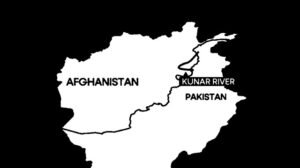Afghanistan to Build Dam over Kunar River
|
General Studies Paper II: India and Its Neighbors, Impact of Policies and Politics of Countries on India’s Interests |
Why in News?
In October 2025, Afghanistan announced the construction of a dam on the Kunar River, a move that could significantly restrict water flow into Pakistan.
- The Taliban-led government, under Supreme Leader Hibatullah Akhundzada, has ordered the Ministry of Water and Energy to expedite the dam’s construction, prioritizing local Afghan companies over foreign contractors.
Kunar River: Geography, Flow, and Regional Importance
- Origin: The Kunar River, approximately 480 kilometers long, originates from the glaciers of the Hindu Kush mountains in the Chitral District of Pakistan. This river, known as the Chitral River in Pakistan, is primarily fed by the melting snow and glaciers of the Hindu Kush range.
- Course: After originating in Pakistan, the river flows southward into Afghanistan, entering the Kunar Province. In Afghanistan, it is referred to as the Kunar River. The river meanders through the mountainous terrains of Kunar Province, joining the Kabul River near the city of Jalalabad. From there, the combined waters flow eastward into Pakistan’s Khyber Pakhtunkhwa province, eventually merging with the Indus River at Attock.
- Tributaries: It has several tributaries, including Shishi River, Lotkoh River, Landai Sin River, Pech River. The Pech River joins the Kunar River at Asadabad in Afghanistan. These tributaries contribute to the river’s flow.
- Importance: The Kunar River plays a crucial role in supporting agriculture in the regions it flows through. Its waters are used for irrigation, enabling the cultivation of various crops that are essential for the local economies. The river provides water for daily consumption and supports local fisheries, making it indispensable for the livelihoods of the people in both Afghanistan and Pakistan.
Political and Diplomatic Context Behind Afghanistan’s Dam Construction
- Recent Border Clashes: In October 2025, Afghanistan and Pakistan experienced their most intense border clashes since the Taliban’s return to power in 2021. The conflict began on October 9 when Pakistan conducted airstrikes targeting Tehrik-e-Taliban Pakistan (TTP) militants in Kabul and other Afghan cities. The Taliban responded by attacking multiple Pakistani military posts along the border. Both sides suffered significant casualties. A ceasefire was brokered by Qatar and Turkey on October 19, but the underlying issues remain unresolved.
- Disputes Over the Durand Line: The Durand Line, established in 1893, demarcates the border between Afghanistan and Pakistan. However, Afghanistan has never officially recognized it as an international boundary. This longstanding dispute has been a source of tension between the two countries, with Afghanistan asserting that the line divides ethnic Pashtun populations and disrupts traditional tribal territories. The lack of recognition has led to frequent border skirmishes and complicates diplomatic relations.
- Afghanistan’s Assertion of Sovereignty: Afghanistan’s Taliban-led government emphasized its right to self-defense and territorial integrity. Afghan officials accused Pakistan of over 1,200 border breaches and 710 airspace incursions between 2021 and 2025, framing these actions as sustained aggression undermining Afghan sovereignty. In response, Afghanistan underscored its right to defend its borders and maintain control over its territory.
Future Impact of the Kunar River Dam Project
- Energy Generation: The Kunar River dam is expected to generate significant hydroelectric power for Afghanistan. The government aims to produce over 45 MW of electricity in future once it’s completed. This energy will support local industries and households, reducing Afghanistan’s reliance on imported electricity.
- Irrigation: The dam will provide controlled irrigation water to Afghanistan’s arid regions. Farmers in Kunar and Nangarhar provinces will benefit from steady water supply throughout the year. It will irrigate 34,000 hectares of agricultural land. It will support cultivation of wheat, maize, and rice in previously rain-dependent areas.
- Employment: Construction of the dam will create thousands of local jobs in Afghanistan. The government prioritizes hiring Afghan engineers, laborers, and contractors. This will boost the economy of Kunar and nearby provinces. Employment generation will also enhance skills and capacity building among the local workforce.
- Water Supply: The dam may reduce the flow of water into Pakistan’s Khyber Pakhtunkhwa and Punjab regions. Pakistan receives 70-80% of Kunar River water and Pakistani farmers depend on the tributaries for irrigation. A decrease in water flow could exacerbate Pakistan’s agriculture water crisis, especially during dry seasons. This will impact more than 20 small hydroelectric projects operating in Pakistan.
- Environmental Implications: The dam has potential environmental impacts, including changes in river ecosystems and sedimentation patterns. Climate studies indicate that reduced downstream flow could affect fisheries and wetlands.
Future Implications for Regional Diplomacy
In future the Kunar River dam project is expected to reshape Afghanistan–Pakistan relations, especially because there are no formal water-sharing agreements or international treaties governing rivers between the two nations. Afghanistan’s decision to construct the dam reflects its intent to use its natural resources for domestic benefit. However, Pakistan has expressed deep concern over the move, fearing a reduction in water flow. Without a binding water-sharing framework like the Indus Waters Treaty that exists between India and Pakistan, the situation creates uncertainty over future resource management.
|
What is the Indus Waters Treaty (IWT)?
|
|
Also Read: Earthquake in Afghanistan |
|
Also Read: China CPEC Expansion Policy to Afghanistan |
|
Also Read: Tamil Nadu Space Industrial Policy |










